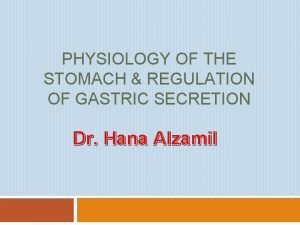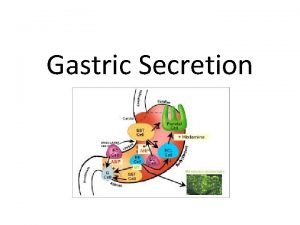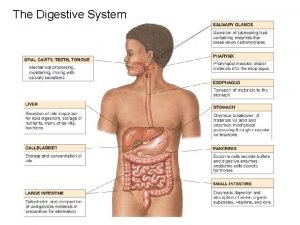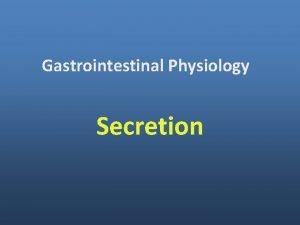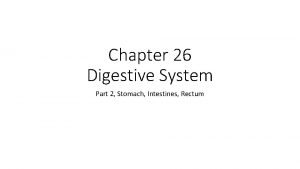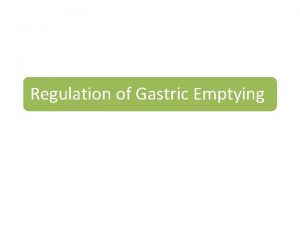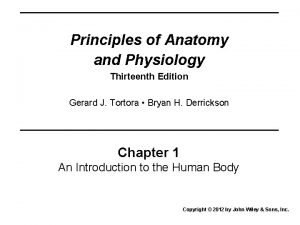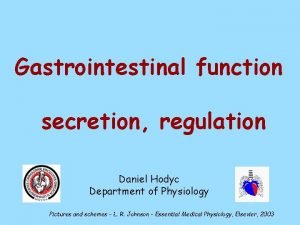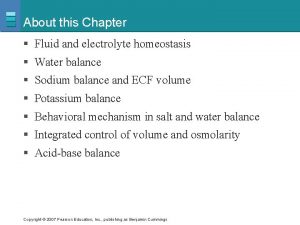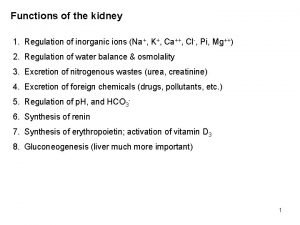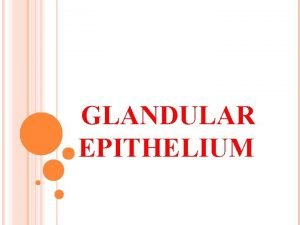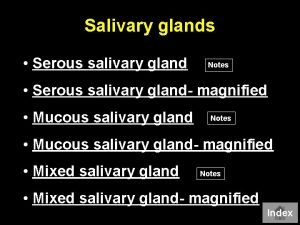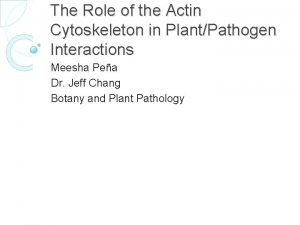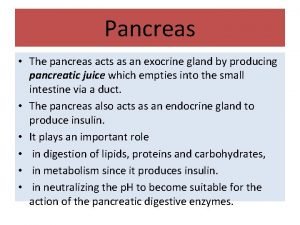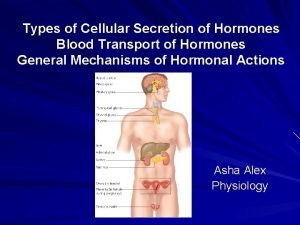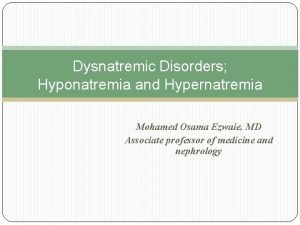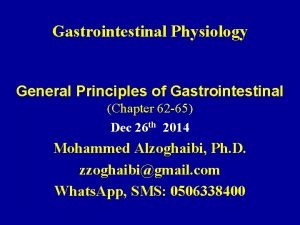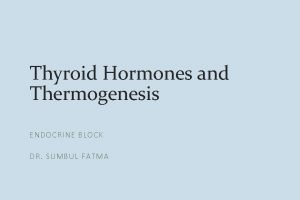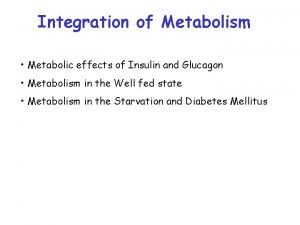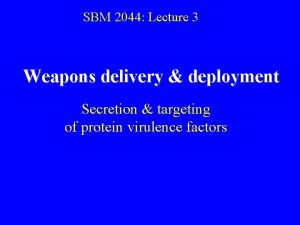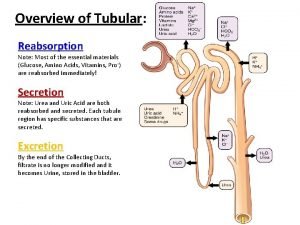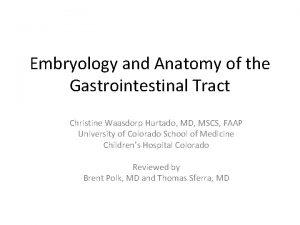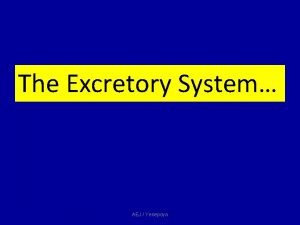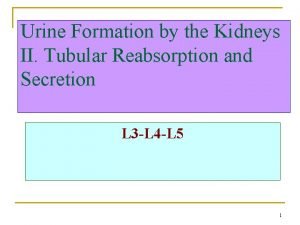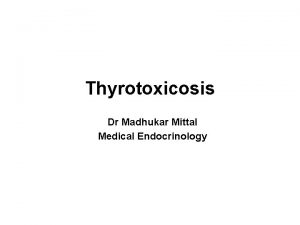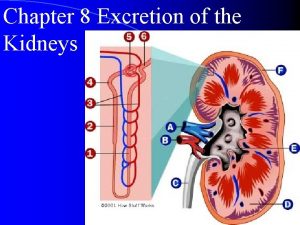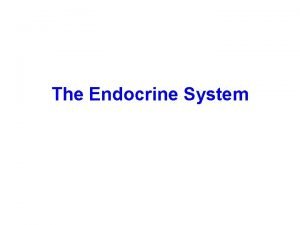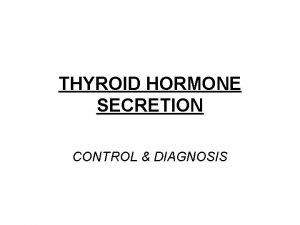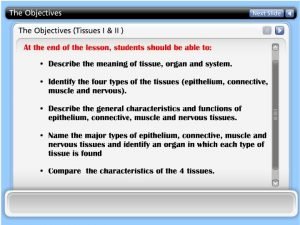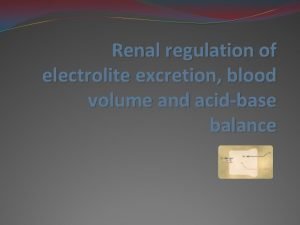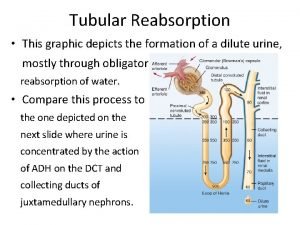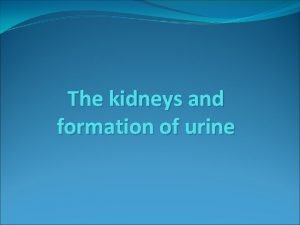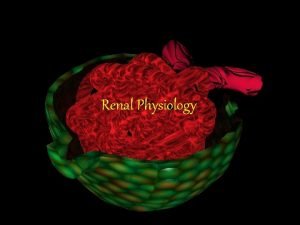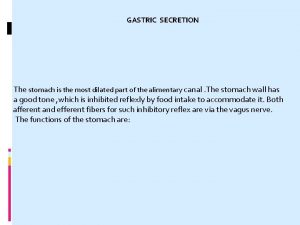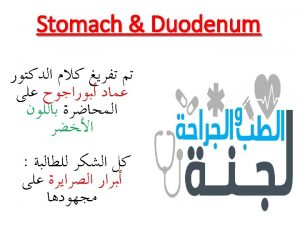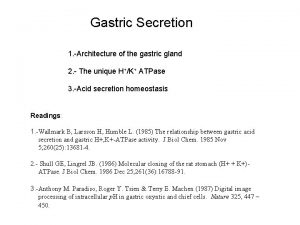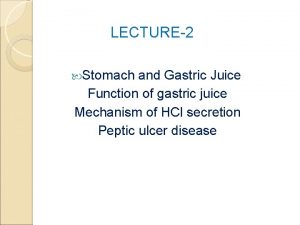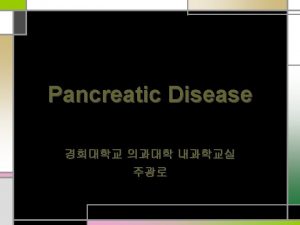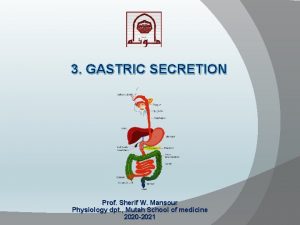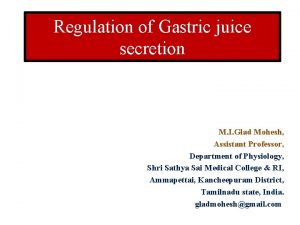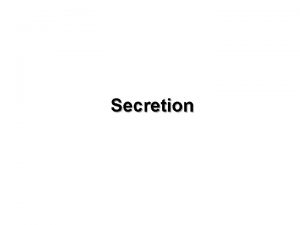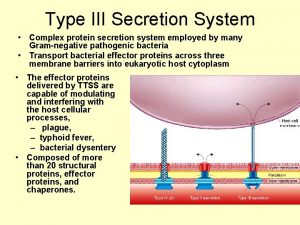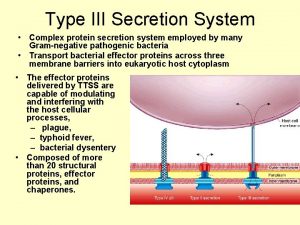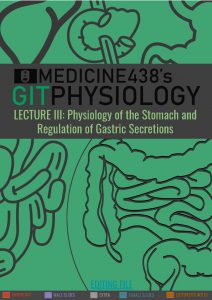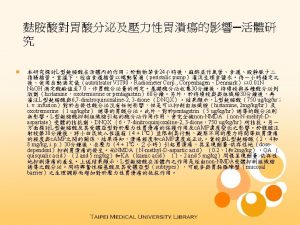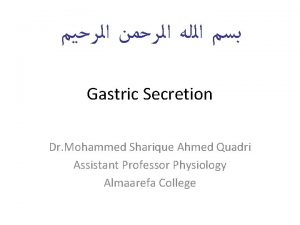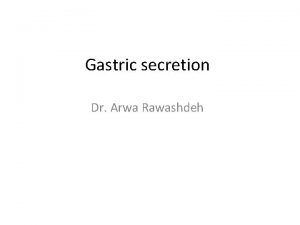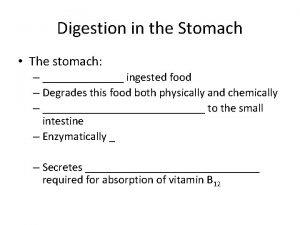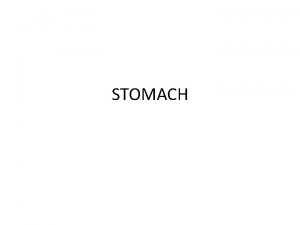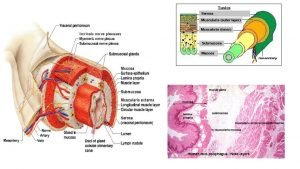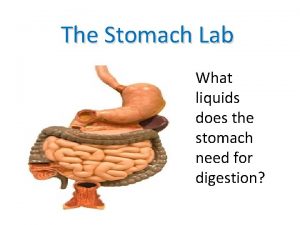PHYSIOLOGY OF THE STOMACH REGULATION OF GASTRIC SECRETION








































- Slides: 40

PHYSIOLOGY OF THE STOMACH & REGULATION OF GASTRIC SECRETION Dr. Hana Alzamil

Objectives o o Functions of stomach Gastric secretion ü Mechanism of HCl formation ü Gastric digestive enzymes ü Neural & hormonal control of gastric secretion ü Phases of gastric secretion Motor functions of the stomach Stomach Emptying


Nutrition Nutrient: substance in food used to promote growth, maintenance, and repair Major nutrients: Carbohydrates – sugars & starches Lipids – saturated/unsaturated fats Proteins – eggs, milk, meat (complete – all AA); legumes, nuts, cereals (incomplete) Vitamins – A, B, C, E, D, K Minerals – Ca, P, K, S, Na, Cl, Mg

Functions of GIT 1. Ingestion - mouth 2. Digestion A. Mechanical – fragment food into smaller particles (teeth, tongue, stomach, small intestine) B. Chemical – enzymes Mouth = carbs Stomach = proteins SI = carbs, proteins, fats, nucleic acids 3. Absorption – transport from SI to blood 4. Defecation – eliminate indigestible residues (feces)

Stomach Stores & breaks down food Mechanical Chemical – churn, mix – protein digestion Gastric juice: converts meal to acidic chyme HCl: p. H 2, kills bacteria, denatures proteins Pepsin: enzyme breaks down proteins Rugae = large folds Mucus = protects lining of stomach

Anatomy & physiology of the stomach Anatomically : Body Antrum Physiologically Orad Caudad

Anatomy & physiology of the stomach Muscular wall Longitudinal Circular Oblique

Motor functions of the stomach 3 motor functions of the stomach: Storage of large quantities of food Mixing of food with gastric secretions to produce chyme Slow emptying of chyme into the small intestine at a suitable rate for proper digestion & absorption

Motor functions of the stomach Storage function: When food stretch the stomach a vagovagal reflex from the stomach to the brain stem Back to the stomach to reduce the tone in the muscular wall in the body of the stomach Stomach wall bulges progressively Stomach will accommodate up to 0. 8 -1. 5 liters Pressure in the stomach remains low

Motor functions of the stomach Mixing and propulsion function: As long as food is in the stomach , weak peristaltic constrictor waves (mixing waves) begin in the mid to upper portions of the stomach wall and move toward the antrum once every 15 -20 seconds It is initiated by the gut wall basic electrical rhythm (slow waves) As the constrictor waves move into the antrum they become more intense Some become extremely intense providing peristaltic action potential-driven constrictor rings that force antral contents under higher pressure toward the pylorus


Motor functions of the stomach Mixing and propulsion function: Constrictor rings play an important role in mixing the stomach contents: Each time it digs deeply into the food contents in the antrum The opening of the pylorus allows only a few mls of antral contents to be expelled into the duodenum with each wave As each wave approaches the pylorus the pyloric muscle contracts Most of the antral content are squeezed upstream through the peristaltic ring toward the body The moving peristaltic ring + upstream squeezing action called Retropulsion is an important mixing mechanism

Motor functions of the stomach Hunger Contractions: Occurs when stomach is empty for several hours They are rhythmical peristaltic contractions in the body of the stomach When successive contractions become extremely strong they fuse into a continuing tetanic contractions that lasts for 2 -3 min Sometimes they cause mild pain (hunger pangs) They begin 12 -24 hrs after last meal In starvation they reach greatest intensity in 3 -4 days

Motor functions of the stomach Stomach Emptying Promoted by intense peristaltic contractions in the antrum Empting is opposed by resistance to passage of chyme at the pylorus Pyloric pump: Most of the time contractions are weak and cause mixing of food with gastric secretions 20% of the time contractions in the form of tight ringlike constrictions cause stomach emptying They are 6 times as powerful as mixing waves

Motor functions of the stomach Role of pylorus in controlling emptying Pylorus is the distal opening of the stomach Thickness of circular muscles is 50 -100% greater than in the antrum It is slightly tonically contracted almost all the time It is named the pyloric sphincter It is usually open enough to allow water & fluids It is controlled by nervous and humoral reflexes from the stomach and duodenum

Motor functions of the stomach Regulation of stomach emptying: Emptying of the stomach is regulated by : Stomach Duodenum (more potent) Gastric factors: Gastric food volume: when volume increased it increased emptying due to stretch of stomach wall which initiate local myenteric reflexes causing: Increase activity of pyloric pump Inhibit the pylorus Gastrin released from antral mucosa and enhance the activity of pyloric pump

Motor functions of the stomach Regulation of stomach emptying: Duodenal factors: Inhibitory enterogastric nervous reflexes mediated by: Direct from duodenum to stomach via enteric nervous system Extrinsic nerves to sympathetic ganglia Vagus nerves to the brain stem All these reflexes strongly inhibit pyloric pump & increase tone of the pyloric sphincter Factors that initiate these reflexes are: Duodenal distention, irritation of mucosa, acidity of duodenal chyme, breakdown products such as proteins & fats Hormonal feedback

Motor functions of the stomach Regulation of stomach emptying: Duodenal factors: Hormonal feedback The main stimulus for releasing these inhibitory hormones is fat in the duodenum Through receptors on epithelial cells Released hormones carried by blood to the stomach They inhibit pyloric pump & increase contraction of pyloric sphincter The most potent hormone, CCK released from jejunum by fat Secretin released from duodenal mucosa in response to acid Gastric inhibitory peptide (GIP) from upper small intestine mainly by fat in chyme and carbohydrates


Gastric secretion Gastric mucosa has numerous openings called gastric pits Gastric glands empty into bottom of pits 4 functionally different cell types compose glands Mucous cells Chief cells Parietal cells Enteroendocrine cells


Secretory functions of the stomach q Characteristics of stomach secretion: q In addition to mucus secreting cells that line the stomach and secrete alkaline mucus there is two important types of tubular glands: oxyntic (gastric) glands Secrete: Pyloric glands Hydrochloric acid Pepsinogen Intrinsic factor Mucus Secrete: Mucus- protection Gastrin Pepsinogen Located in the antrum In the distal 20% of stomach Located in body & fundus In proximal 80%of stomach



Postulated mechanism for secretion of hydrochloric acid. (The points labeled "P" indicate active pumps, and the dashed lines represent free diffusion and osmosis. )

Mechanism of HCL secretion https: //t. co/P 67 w 1 Tr. SZc


Neural & Hormonal Control of Gastric Secretion v Vagus nerve (neural effector) either by releasing Ach (direct activation of parietal cells) or by releasing Gastrin releasing peptide, GRP (indirect activation). v Gastrin (hormonal effector) v Enterochromaffin-like cells release Histamine activates H 2 receptor (parietal cells) increases acid secretion Ø Cimetidine (H 2 receptor blocker) peptic ulcer and gastroesophageal reflux

Phases of gastric secretion https: //youtu. be/if. Dp 57 pv. KOg

Phases of gastric secretion

Phases of gastric secretion

Phases of gastric secretion

Gastric secretion

Secretory products of various gastric cells

Agents that stimulate and inhibit H+ secretion by gastric parietal cells


Digestion of carbohydrate in mouth & stomach mixed with saliva that contain ptyalin (an α amylase) secreted by parotid gland It hydrolysis starch to maltose It continues in stomach for 1 hr Gastric acid deactivate it Food

Digestion of proteins in the stomach Pepsin secreted by chief (peptic) cells It is active at p. H 2 -3 and inactive at p. H 5 Initiate protein digestion (10 -20% of protein digestion) Can digest collagen Hydrochloric secreted acid by parital (oxyntic) cells

Absorption Stomach is a poor absorptive area of GIT It lacks the villous type of absorptive membrane It has tight junctions between epithelial cells Only a few highly-lipid soluble substances can be absorbed such as: Alcohol Aspirin
 Function of stomach
Function of stomach Peptic cells secrete
Peptic cells secrete Secretion of gastric juice
Secretion of gastric juice Enteropancreatic reflex
Enteropancreatic reflex Ingestion digestive system
Ingestion digestive system Trifoliate duodenum meaning
Trifoliate duodenum meaning Gastric folds in stomach
Gastric folds in stomach What is pyloric pump
What is pyloric pump Contraction
Contraction Right subcostal region
Right subcostal region Saliva composition
Saliva composition H+ secretion in proximal tubule
H+ secretion in proximal tubule Tubular reabsorption and secretion
Tubular reabsorption and secretion Merocrine glands
Merocrine glands What is serous secretion
What is serous secretion Reabsorption
Reabsorption Type 3 secretion system
Type 3 secretion system Is bile in pancreatic juice
Is bile in pancreatic juice Gsis
Gsis Types of hormone secretion
Types of hormone secretion Adh secretion
Adh secretion Components of bile
Components of bile Thyroid hormone secretion
Thyroid hormone secretion Hormone secretion
Hormone secretion Type 3 secretion system
Type 3 secretion system Reabsorption in the kidney
Reabsorption in the kidney Embryology of git
Embryology of git Osmoaia
Osmoaia Sodium reabsorption
Sodium reabsorption Synthesis and secretion of thyroid hormones
Synthesis and secretion of thyroid hormones Hydrogen secretion in kidney
Hydrogen secretion in kidney Msh secretion
Msh secretion Erythropin
Erythropin Holocrine secretion
Holocrine secretion H+ secretion in proximal tubule
H+ secretion in proximal tubule Macula densa
Macula densa Tubular secretion
Tubular secretion Where does tubular secretion occur
Where does tubular secretion occur Pseudostratified columnar
Pseudostratified columnar Where does secretion occur in nephron
Where does secretion occur in nephron Gấu đi như thế nào
Gấu đi như thế nào
